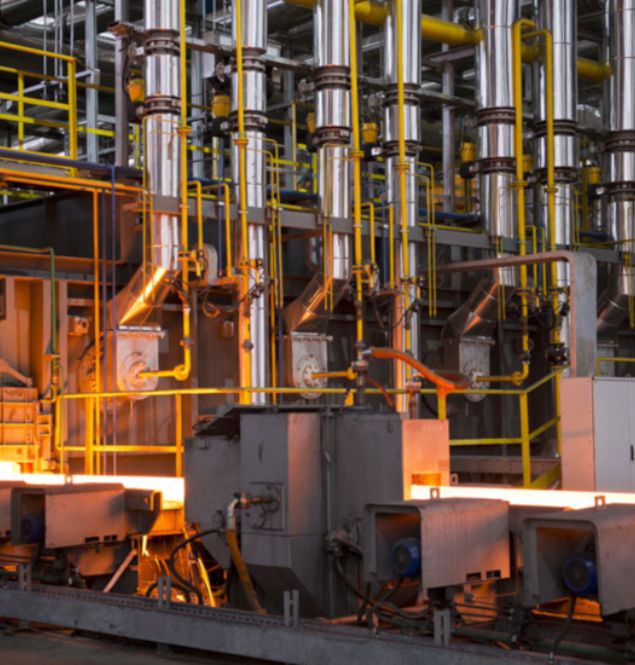Get In Touch
- 55 Main Street, 2nd Block, USA
- [email protected]
- +000 (123) 456 88
Gallery






Get In Touch
- 55 Main Street, 2nd Block, USA
- [email protected]
- +000 (123) 456 88
Gallery







Leading Manufacturer of Heat Treatment Furnaces
Trymax Furnace delivers advanced industrial heat treatment furnaces—including vacuum, continuous, pit, and gas/electric-fired systems—engineered for processes like hardening, annealing, quenching, and solution treatment with high uniformity, energy efficiency, and API / AMS standard compliance.

Applications of Heat Treatment Furnaces
- Our industrial heat treatment furnaces support annealing, normalising, hardening, tempering, and stress-relieving of steel and aluminium — ideal for forging, castings, and pump parts.
- We deliver vacuum heat treatment furnaces and gas-atmosphere furnaces for solution treatment, ageing, and bright annealing of non-ferrous metals.
- Our continuous and batch heat treat furnaces are used across aerospace, automotive, foundry, forging, railways, and power sectors.
- We also provide post-weld heat treatment furnaces, quenching furnaces, and stress-relieving furnaces, conforming to AMS 2750, NADCAP, and CQI-9 standards.
Weight: 1500-2000 kg
Electric Driven
Voltage: 440V
Hardening Process
Types of Heat Treatment Furnaces & Processes
Trymax Furnace offers a wide range of heat treatment furnaces, including electric, gas-fired, or vacuum furnaces, and continuous / batch furnaces to suit different heat treatment processes. In heat treatment, methods such as hardening (quenching), tempering, annealing, and normalizing are employed to control material properties—strength, ductility, grain structure, and stress relief.


Heat Treatment Processes
Heat treatment processes include annealing, hardening, tempering, and normalizing, as noted by Sun Furnace.
- Hardening involves heating to form austenite, then rapidly cooling to generate high strength.
- Tempering reheats hardened parts at a lower temperature to adjust toughness and remove stresses.
- Annealing slowly cools heated parts, boosting ductility and machinability.
- Normalising heats above the critical point and then air cools, refining microstructure and removing internal stress.

Heat Treatment and Its Role in Metal
Processing
Heat treatment is a controlled heating and cooling process applied to metals — including steel, aluminium, and alloys — to precisely modify their physical and mechanical properties, such as hardness, ductility, toughness, and strength. There are several key types of heat treatment: annealing, which softens metal and refines its microstructure; normalizing, which relieves stress and creates a uniform grain size; quenching, a rapid cooling method that hardens metal; and tempering, which optimizes brittleness versus toughness after quenching
Material: Aluminum, Stainless Steel
Automatic Operation
Weight: 3000-4000 kg
Electric Driven
Importance of Heat Treatment Furnace
Heat treatment furnaces are essential for delivering controlled heating and cooling in industrial heat treatment processes, enabling uniform temperature control and precise atmosphere regulation. This ensures improved hardness, strength, and durability in metals, reducing defects and enhancing industrial furnace performance.


Differences Between a Heat Treatment Furnace and an Industrial Furnace
A heat treatment furnace is a specialised industrial furnace used to precisely control heating, soaking, and cooling to carry out heat treatment processes like hardening, tempering, annealing, and normalising, changing the internal properties of metals. In contrast, an industrial furnace is a broader category encompassing all furnaces used for industrial purposes—melting, sintering, drying, or heating—and is not limited to heat treatment.
Enhanced Material Strength
Increased Durability
Controlled Hardening
High Precision
The Basic Function of Heat Treatment
Heat treatment fundamentally involves heating and cooling metal materials in an industrial furnace to modify their microstructure. By precisely controlling processes like hardening, tempering, annealing, and normalizing, heat treatment improves properties — such as toughness, hardness, and elasticity — in heat treat furnace operations. This core function of heat treatment is central to modern heat treatment processes and heat treatment furnace applications.

Established
Completed
Served
Heat Treatment Furnace Manufacturers in india
What is the process of heat treatment in a furnace?
What are the main types of heat treatment used in industry?
The four core types are annealing (softening and stress relief), normalizing (refining grain structure), hardening/quenching (rapid cooling to increase strength), and tempering (rebalancing toughness after hardening). These are implemented across electric, gas, pit, continuous, and vacuum heat treatment furnaces.
Which industries in India use heat treatment furnaces?
What is a vacuum heat treatment furnace and when is it used?
Which standards and certifications matter for heat treating (NADCAP / AMS / CQI-9)?
Aerospace and critical applications require pyrometry and process control to AMS-2750 (pyrometry) and often NADCAP accreditation; automotive/supplier quality systems reference CQI-9 for thermal processing controls. Manufacturers in India advertise compliance to these standards for high-precision furnaces.
How should I choose a heat treatment furnace manufacturer in India?
Select a manufacturer offering the right furnace type (vacuum, electric, gas, pit, continuous/batch), documented process capability for annealing/hardening/tempering, pyrometry compliance (AMS-2750/CQI-9/NADCAP where required), energy-efficient designs, and after-sales service—compare Indian suppliers’ case studies and technical specs before purchasing.




























